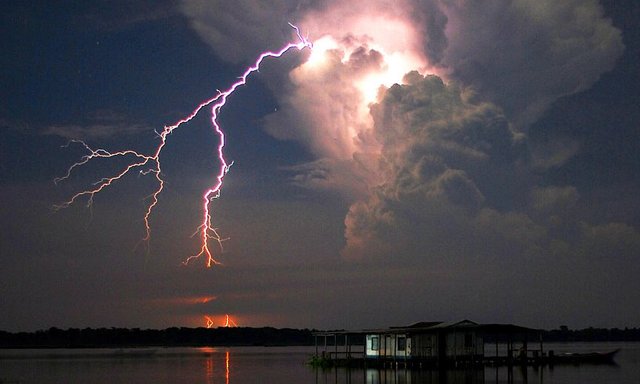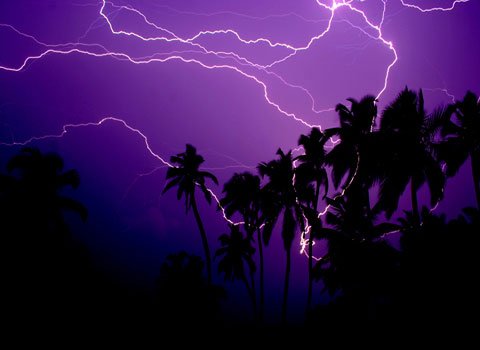
Lake of Maracibo, Zulia, Venezuela.
Hello friends of steemit, I want to share with you an interesting topic that has always caught my attention. In Venezuela there is a natural phenomenon that originates on the surface of the lake of the city of Maracaibo in Zulia State, this phenomenon is called The Lightning of the Catatumbo.
This natural phenomenon is characterized by the appearance of a series of lightning almost continuously and virtually silent for the large distances needed to observe the phenomenon, which occurs in clouds of great vertical development forming electrical discharges between 1 and almost 4 kilometers of height.
The origin of this phenomenon is in the orographic effect of these mountain ranges that enclose and brake the northeasterly winds; thus, clouds of great vertical development are produced, concentrated mainly in the Catatumbo river basin. This phenomenon is very easy to see from hundreds of kilometers away, as from Cúcuta, in Colombia, or from the lake itself (where there are usually no clouds at night). For this reason, it is also known as the Maracaibo Lighthouse, since the boats that sailed the area could sail during the night without problems at the time of sailing. It can occur up to 260 times a year and lasts up to 10 hours per night; In addition, this phenomenon can reach 60 downloads per minute.

The Catatumbo lightning is usually developed between the coordinates of 8º 30 'and 9º 45' north latitude and 71º and 73º west longitude, which is a very large area although, as is logical, not all of this area always has the same stormy activity. The most remote areas of this large area are occupied by indigenous groups, which always tenaciously resisted the domination by the Spaniards first and those who tried to exploit their territory later. And it was very recently when they accepted the participation of Spanish missionaries (in the second half of the 20th century), who founded several mission towns such as the Tukuko people and others. In the village of Tukuko, a simple meteorological station was installed and in several years of observation the annual rainfall never dropped below 4,000 mm, which serves to give an example of the raininess of the area. n turn, this also explains the great flow of the Catatumbo River, which, with some 500 km in length, is navigable over a large part of its route. The final part of its course has numerous meanders and delivers to the lake of Maracaibo an enormous amount of sediments, ending in a delta that has been built in the lake itself. In fact, if it were not for the fact that the lake constitutes a zone of land subsidence (that is, a sedimentary or subsidence basin), the sediments contributed by the river have long covered the lake completely.

Many researchers in various areas have tried to find the root cause of the lightning phenomenon, for this reason, there are a variety of hypotheses, which I can mention below:
The Center for Scientific Modeling (CMC) has been making expeditions to the region of interest since the year of 1998 in order to determine the probable causes of the phenomenon, one of the most outstanding was the week of April 12 to 15, 2015 , with the participation of researchers from the Virtual Meteorology Center (CvM), the Aviation Meteorology Service and the International Research Institute for Climate and Society.
This expedition consisted of the launching of several meteorological balloons inflated with hydrogen and tied to earth up to the height of the base of the clouds (about 1000 meters), equipped with autonomous recorders (designed and built by the CMC), recording atmospheric pressure, temperature and environmental humidity at heights of 10, 500 and 1000 meters during periods of several continuous hours from two different locations during the four days of the campaign.
During each measurement period, the captive balloons were successfully recovered and the data captured by the recorders were downloaded by means of portable computers in the field; These data will allow to fine-tune the forecasting and early warning systems for adverse events that the Integrated Monitoring System of the Lake Maracaibo Basin currently maintains.
These researchers published a study6 in January 2016 demonstrating that it is possible to generate lightning forecasts for the Lake Maracaibo basin months in advance (seasonal forecasts). The prediction methodology is based on the effect of the so-called Low Level Nocturnal Jet of the Lake Maracaibo Basin, a "tide" of winds that moves from north to south and from south to north at different times of the day.